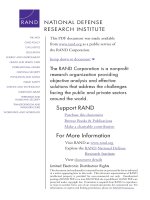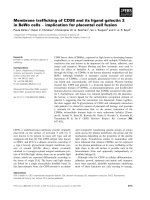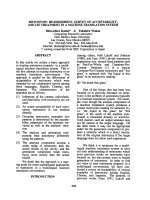Lecture Principle of inventory and material management - Lecture 3: Production Planning System
Bạn đang xem bản rút gọn của tài liệu. Xem và tải ngay bản đầy đủ của tài liệu tại đây (501.27 KB, 43 trang )
Lecture 3
Production Planning System
Books
•
Introduction to Materials Management, Sixth Edition, J. R. Tony Arnold, P.E., CFPIM, CIRM, Fleming
College, Emeritus, Stephen N. Chapman, Ph.D., CFPIM, North Carolina State University, Lloyd M.
Clive, P.E., CFPIM, Fleming College
•
Operations Management for Competitive Advantage, 11th Edition, by Chase, Jacobs, and Aquilano, 2005,
N.Y.: McGrawHill/Irwin.
Manufacturing’s Objectives
•
The goal of manufacturing is to produce
–
The right goods
–
Of the right quality
–
In the right quantities
–
At the right time
–
At minimum cost
Objectives
•
•
•
•
•
•
Manufacturing Planning and Control System
Sales and operations planning (SOP)
Making production plan
Developing production plan
Market to stock production plan
Market to order production plan
Four Basic Questions
What are
we going
to make?
What does
it take to
make it?
What
do we
already
have?
What must
we get?
Priority
The APICS Dictionary defines priority as “the relative
importance of jobs, i.e., the sequence in which jobs
should be worked on.” Priority refers to what is
needed, how much is needed, and when it is
needed.
Capacity
The APICS Dictionary defines capacity as “the
capability of a worker, machine, work center, plant
or organization to produce output per time period.”
Priority Management Techniques
Production Plan
Resource
Requirements
Plan (RRP)
Master Production
Schedule (MPS)
Rough-Cut
Capacity
Plan (RCCP)
Material
Requirements
Plan (MRP)
Capacity
Requirements
Plan (CRP)
Production Activity
Control (PAC)
Input/Output Control
Operation Sequencing
Capacity Management Techniques
Strategic Business
Plan
Manufacturing Planning and Control System
•
Strategic Business Plan
A statement of the major goals and objectives the company
expects to achieve over the next 210 years or more.
–
–
–
–
–
–
broad/general direction
low level of detail
longrange forecasts
responsibility of senior management
includes participation from Marketing, Finance, and
Production
usually reviewed every six months to a year
Manufacturing Planning and Control System
•
Production Plan Concerns
–
–
–
–
Quantities of each product group required to be
produced
The desired inventory levels
The resources of equipment, labor, and material needed
in each period
The availability of resources needed
Manufacturing Planning and Control System
•
Production Plan must
–
–
–
–
–
–
Satisfy market demand within resources available
Assist the implementation of the strategic business plan
Be based upon families of products
Be fairly low level of detail
Address a planning horizon of six to 18 months
Be reviewed each month or quarter
Manufacturing Planning and Control System
•
Master Production Schedule
A plan for the production of individual end items (finished
goods).
–
–
–
–
–
breaks down production plan
list the quantity of each end item to be made
level of detail is higher than the production plan
developed for individual end items
planning horizon extends three to 18 months
reviewed and changed weekly or monthly
Manufacturing Planning and Control System
•
Material Requirements Plan
A plan for the production and purchase of the components
used in making the items in the MPS
–
–
–
–
–
Production control and purchasing use MRP to decide
the purchase or manufacture of specific items
Level of detail is high
Determines when the components and parts are needed
Planning horizon is at least as long as the combined
purchase and manufacture lead times (3 to 18 months)
Usually reviewed daily or weekly
Manufacturing Planning and Control System
•
Production Activity Control and Purchasing
–
Represents the implementation and control phase of the
production planning and control system
–
Purchasing is responsible for establishing and
controlling the flow of raw materials into the factory
–
PAC is responsible for planning and controlling the
flow of work through the factory
–
Planning horizon is very short, a day to a month
–
Level of detail is high
–
Reviewed and revised daily
Manufacturing Planning and Control System
2
At each level in the MPCS, three
questions must be answered:
–
–
What are the priorities how much of
what is to be produced and when?
What is the available capacity what
resources do we have?
•
–
Can we outsource?
How can differences between priorities
and capacity be resolved?
Manufacturing Resource Planning (MRP II)
•
Manufacturing resource planning (MRP II) is a method for the
effective planning of all resources of a manufacturing company.
Ideally, it addresses operational planning in units, financial
planning in dollars, and has a simulation capability to answer
“what if” questions. It is made up of a variety of functions, each
linked together: business planning, sales and operations planning,
production planning, master production scheduling, material
requirements planning, capacity requirements planning, and the
execution support systems for capacity and material. Output from
these systems is integrated with financial reports such as the
business plan, purchase commitment report, shipping budget, and
inventory projections in dollars.
APICS Dictionary, 8th edition, 1995
Sales and operations planning (SOP)
•
•
Medium time range
Benefits:
–
–
–
Provides a means of updating the strategic business
plan
Provides a means of managing change
Permits better management of production, inventory
and backlog
Making the Production Plan
•
Purpose
Production planning is
. . . setting the overall level of manufacturing output . . .
and other activities to best satisfy the current
planned levels of sales . . . while meeting general
business objectives of profitability, productivity . . .
etc., as expressed in the overall business plan.
APICS Dictionary, 8th edition, 1995
Making the Production Plan
•
Production planning is concerned with
–
–
–
–
•
•
The quantities of each product group in each period.
The desired inventory levels.
The resources of equipment, labor, and material needed in
each period.
The availability of needed resources.
Why are plans made for product groups?
What should the product groups be based on?
Making the Production Plan
•
•
Production planning characteristics
–
The time horizon may be more or less than 12
months, depending on the manufacturing cycle.
–
Demand is seasonal for many products, but not for
all. Seasonal demand is the worstcase scenario.
–
A plan is made for families or groups.
–
Management will have a variety of objectives.
What might be some management objectives?
Developing the Production Plan
•
Three Basic Strategies
–
–
–
•
Chase (Demand Matching) Strategy: Produce the
amounts that are demanded at any one time
Production Leveling Strategy: Continuously
produce an amount equal to the average demand
Subcontracting: Meeting additional demand
through subcontracting.
Hybrid Strategy: Combination of any of the
above strategies
Units
Developing the Production Plan
1
2
3
4
5 6 7
Periods
8
9
10
Chase (demand matching) Strategy
11
12
The goal is to produce the amounts demanded at any
given time. Inventory levels remain stable while
production varies to meet demand
Developing the Production Plan
•
Chase Strategy Disadvantages
–
–
–
As production increases, workers must be hired and
trained. Extra shifts may be needed, and overtime may
be necessary. These requirements all increase cost.
As production decreases, people are laid off and
morale suffers,
When production starts to increase again, the best
workers may have other jobs and their skills will not be
available.
Developing the Production Plan
•
•
Chase Strategy Disadvantages (continued)
–
Manufacturing must have enough plant capacity to
produce at the highest capacity needed.
What industries use a chase strategy?
Developing the Production Plan
Production Leveling Strategy
The goal of this strategy is to continuously produce an
amount equal to the average demand.
Unit
s
•
1
2
3
4
5
6 7 8
Periods
9
10
11
12
Developing the Production Plan
•
•
Production Leveling Strategy
–
This strategy avoids the disadvantages of demand
matching. However, inventory builds up.
What are some examples of industries that could use this
strategy?









